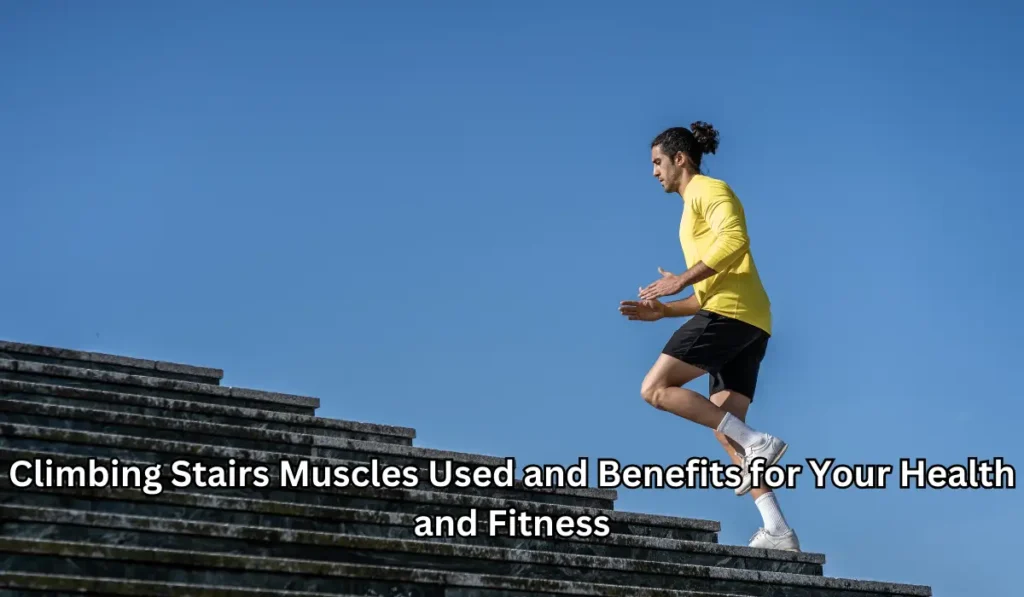
Climbing Stairs Muscles Used and Benefits for Your Health and Fitness
Are you looking for an effective and convenient way to improve your overall health and fitness? Look no further than the nearest staircase. Climbing stairs is a simple and efficient way to get your heart pumping, burn calories, and tone your muscles.
But what muscles are actually used during stair climbing, and what are the specific benefits? In this article, we’ll dive into the mechanics of stair climbing and explore the many ways it can benefit your health and fitness.
First, we’ll take a look at the muscles used during stair climbing, including the glutes, hamstrings, quadriceps, calves, and core muscles. Understanding which muscles are working during this exercise can help you focus on proper form and maximize the benefits.
Next, we’ll explore the various health benefits of stair climbing. From improving cardiovascular health and burning calories to building endurance and strength, stair climbing is a versatile exercise that can benefit people of all fitness levels.
Finally, we’ll discuss how to incorporate stair climbing into your exercise routine, whether you’re a beginner looking to start small or a seasoned fitness enthusiast looking to challenge yourself.
So, whether you’re looking to improve your overall fitness, lose weight, or simply add some variety to your exercise routine, climbing stairs can be a great way to achieve your goals. Let’s dive in and learn more about the muscles used and benefits of stair climbing.
Read about Comparing Pre Workout vs Creatine
Muscles Used During Stair Climbing
Stair climbing is a great way to engage multiple muscle groups throughout your body. The primary muscles used during stair climbing include:
- Glutes: The gluteus maximus is the largest muscle in your body and is responsible for hip extension and leg power during stair climbing.
- Hamstrings: The hamstrings are located on the back of your thighs and help support the glutes in extending the hips and knees during stair climbing.
- Quadriceps: The quadriceps are located on the front of your thighs and are responsible for knee extension, allowing you to push off the ground and take each step up the stairs.
- Calves: The calves, specifically the gastrocnemius and soleus muscles, work together to extend your ankles and push you off the ground during each step up the stairs.
- Core muscles: Your core muscles, including your abdominal and lower back muscles, work to stabilize your body and maintain proper posture during stair climbing.

Overall, stair climbing engages many of the major muscle groups in your lower body, making it an excellent exercise for toning and strengthening your legs and glutes. Additionally, because stair climbing is a weight-bearing exercise, it can also help improve bone density and reduce the risk of osteoporosis.
Benefits of Stair Climbing for Your Health and Fitness
Stair climbing has numerous benefits for your health and fitness. Here are some of the main advantages of incorporating stair climbing into your exercise routine:
- Improves cardiovascular health: Stair climbing is a great cardiovascular workout that gets your heart rate up and helps improve circulation. Regular stair climbing can lower your risk of heart disease, stroke, and other cardiovascular problems.
- Burns calories and aids in weight loss: Stair climbing is a high-intensity exercise that burns a significant number of calories. A 150-pound person can burn about 476 calories in 30 minutes of stair climbing. This makes stair climbing an effective way to lose weight and maintain a healthy body composition.
- Builds endurance and stamina: Stair climbing is a great way to build endurance and stamina, making it easier to perform other physical activities and exercise routines.
- Tones and strengthens muscles: Stair climbing engages many of the major muscle groups in your lower body, including your glutes, hamstrings, quadriceps, and calves. Regular stair climbing can help tone and strengthen these muscles, leading to improved athletic performance, balance, and stability.
- Improves bone health: Stair climbing is a weight-bearing exercise that can help improve bone density and reduce the risk of osteoporosis.
- Low-impact exercise: Stair climbing is a low-impact exercise that is easier on your joints than other high-impact exercises like running. This makes it a great option for individuals with joint pain or other mobility issues.
Overall, stair climbing is an effective and efficient way to improve your health and fitness. Whether you’re looking to improve your cardiovascular health, lose weight, or build muscle, stair climbing is a simple and convenient exercise that can help you achieve your goals.
Read about Alexa Bliss Bodybuilding
Cardiovascular Benefits of Stair Climbing
Stair climbing is a great way to improve your cardiovascular health. Here are some of the main cardiovascular benefits of stair climbing:
- Increases heart rate: Stair climbing is a high-intensity exercise that raises your heart rate and improves cardiovascular function. The increased heart rate helps pump more blood and oxygen to your muscles, improving your endurance and stamina.
- Improves lung function: Stair climbing is a demanding exercise that requires your body to take in more oxygen. Regular stair climbing can help improve your lung function and increase your lung capacity, making it easier to perform other physical activities.
- Lowers blood pressure: Regular stair climbing can help lower blood pressure, which is a major risk factor for heart disease and other cardiovascular problems. The increased cardiovascular activity during stair climbing helps improve the elasticity of your blood vessels, allowing them to dilate and lower blood pressure.
- Reduces cholesterol levels: Stair climbing is a great way to lower cholesterol levels, which can reduce the risk of heart disease and stroke. The increased physical activity during stair climbing helps raise HDL cholesterol levels (the “good” cholesterol) and lower LDL cholesterol levels (the “bad” cholesterol).
- Boosts circulation: Stair climbing helps improve circulation throughout your body, allowing your muscles to receive more oxygen and nutrients. Improved circulation can also help reduce the risk of blood clots and other circulatory problems.
Overall, stair climbing is an effective way to improve your cardiovascular health and reduce the risk of heart disease and other cardiovascular problems. By incorporating stair climbing into your exercise routine, you can improve your endurance, stamina, and overall cardiovascular function.
Stair Climbing for Burning Calories and Weight Loss
Stair Climbing for Building Endurance and Strength
Stair climbing is a great way to build endurance and strength. Here are some of the main benefits of stair climbing for building endurance and strength:
- High-intensity exercise: Stair climbing is a high-intensity exercise that requires a lot of energy and endurance. By regularly practicing stair climbing, you can build your endurance and stamina, making it easier to perform other physical activities and exercises.
- Engages multiple muscle groups: Stair climbing engages many of the major muscle groups in your lower body, including your glutes, hamstrings, quadriceps, and calves. By regularly practicing stair climbing, you can tone and strengthen these muscles, improving your overall athletic performance, balance, and stability.
- Improves cardiovascular health: Stair climbing is a great cardiovascular workout that gets your heart rate up and improves circulation. By regularly practicing stair climbing, you can improve your cardiovascular health, which is essential for building endurance and stamina.
- Low-impact exercise: Stair climbing is a low-impact exercise that is easier on your joints than other high-impact exercises like running. This makes it a great option for individuals with joint pain or other mobility issues who want to build endurance and strength.
- Can be done anywhere: Stair climbing can be done almost anywhere, making it a convenient exercise that can be incorporated into your daily routine. You can climb stairs at home, at work, or in a public space like a park or stadium.
Overall, stair climbing is an effective way to build endurance and strength. By incorporating stair climbing into your exercise routine, you can tone and strengthen your muscles, improve your cardiovascular health, and build endurance and stamina. Whether you’re looking to improve your athletic performance or simply stay active, stair climbing is a great option for building endurance and strength.
Incorporating Stair Climbing into Your Exercise Routine
Stair climbing is a great way to burn calories and lose weight. Here are some of the main benefits of stair climbing for weight loss:
- High-intensity exercise: Stair climbing is a high-intensity exercise that burns a significant number of calories. The exertion required to climb stairs increases your heart rate, which leads to more calories burned.
- Full-body workout: Stair climbing engages many of the major muscle groups in your lower body, making it a full-body workout that burns calories and tones muscles.
- Burns more calories than walking: Stair climbing burns more calories than walking at a moderate pace, making it a more effective exercise for weight loss.
- Can be done anywhere: Stair climbing can be done almost anywhere, making it a convenient exercise that can be incorporated into your daily routine. You can climb stairs at home, at work, or in a public space like a park or stadium.
- Low-impact exercise: Stair climbing is a low-impact exercise that is easier on your joints than other high-impact exercises like running. This makes it a great option for individuals with joint pain or other mobility issues.
- Increases metabolism: Stair climbing can help increase your metabolism, which is the rate at which your body burns calories. By increasing your metabolism, you can burn more calories even when you’re not exercising.
Overall, stair climbing is an effective way to burn calories and lose weight. By incorporating stair climbing into your exercise routine, you can burn calories, tone muscles, and improve your overall health and fitness. Whether you’re looking to lose weight or maintain a healthy body composition, stair climbing can help you achieve your goals.

Tips for Safe and Effective Stair Climbing
Stair climbing is a safe and effective exercise, but there are a few things to keep in mind to ensure that you’re getting the most out of your workout while minimizing the risk of injury. Here are some tips for safe and effective stair climbing:
- Warm up: Before starting your stair climbing workout, take a few minutes to warm up with some light cardio and stretching. This will help prepare your muscles for the workout and reduce the risk of injury.
- Use proper form: When climbing stairs, use proper form by keeping your back straight, engaging your core muscles, and taking each step one at a time. Avoid leaning forward or twisting your body, which can put stress on your joints.
- Take breaks if needed: If you’re new to stair climbing or find it challenging, take breaks as needed. It’s better to take a short break than to push yourself too hard and risk injury.
- Wear supportive shoes: Wear shoes with good arch support and a non-slip sole to prevent slipping or falling on the stairs.
- Start with a manageable pace: Start with a manageable pace and gradually increase your speed and intensity as your fitness level improves. Remember, stair climbing is a high-intensity exercise that can be challenging, so don’t push yourself too hard too fast.
- Stay hydrated: Drink plenty of water before, during, and after your stair climbing workout to stay hydrated and avoid dehydration.
- Cool down and stretch: After your workout, take a few minutes to cool down and stretch your muscles. This will help prevent muscle soreness and improve your flexibility.
By following these tips, you can safely and effectively incorporate stair climbing into your exercise routine, improving your overall health and fitness.
Conclusion: The Many Benefits of Stair Climbing for Your Health and Fitness
Stair climbing is a simple and effective way to improve your health and fitness. By engaging multiple muscle groups and providing cardiovascular benefits, stair climbing can help you achieve your fitness goals and maintain a healthy lifestyle. Stair climbing can help you burn calories, build endurance and strength, and improve your cardiovascular health. It’s a versatile exercise that can be done almost anywhere, making it a convenient addition to your daily routine.
When practicing stair climbing, it’s important to use proper form and gradually increase your intensity to avoid injury. By following some simple tips for safe and effective stair climbing, you can make the most of this powerful exercise and enjoy all the benefits it has to offer.
Whether you’re looking to lose weight, build muscle, or simply stay active, stair climbing is a great option for improving your health and fitness. So the next time you come across a staircase, consider taking the stairs instead of the elevator or escalator, and reap the many benefits of this simple yet effective exercise.